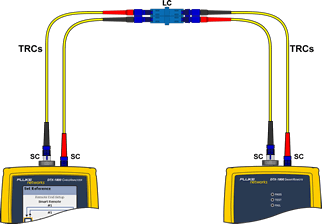Negative loss readings reported with the DTX-SFM2
Incorrect test reference method - if your reference looks like this, you are doing it wrong.

When you set a reference this way, you have no idea what the loss is in that bulkhead adapter. The loss in that bulkhead adapter is subtracted from your loss measurement, which is how you can end up with a negative loss. This method is not permitted in ISO/IEC 14763-3 (ISO/IEC 11801) and is discouraged in ANSI/TIA-568-C.0 for this reason. Most cabling vendors will refuse to issue you a warranty for the cabling system using this 2 jumper style reference method.
If you follow the procedures in the knowledge base articles below, you will no longer see negative loss readings.
- ANSI/TIA-568-C testing LC to LC Duplex Singlemode
- ANSI/TIA-568-C testing SC to SC Duplex Singlemode
- ANSI/TIA-568-C testing SC/APC to SC/APC Duplex Singlemode
- ANSI/TIA-568-C testing ST to ST Duplex Singlemode
- ISO/IEC 14763-3 testing LC to LC Duplex Singlemode
- ISO/IEC 14763-3 testing SC to SC Duplex Singlemode
- ISO/IEC 14763-3 testing SC/APC to SC/APC Duplex Singlemode
- ISO/IEC 14763-3 testing ST to ST Duplex Singlemode
Not allowing the source to stabilize
When you set a reference, the DTX CableAnalyzer will store the received power from the output. For example, with a DTX-SFM2 the received power may be -6,90 dBm. With your reference leads still in place, running an AUTOTEST should yield 0,00 dB. But, let's assume that the source was not allowed to stabilize (warm up). When the source warms up, the output power of the source will increase. Taking the previous example here, the received power increased to -6,50 dBm. Running the AUTOTEST again would yield a negative loss of -0,40 dB.
How long should it take for the source to stabilize? This will depend on where it was stored and the ambient temperature you are testing at. It can be as little as 5 minutes and as long as 30 minutes if the instrument was stored in a very cold place. Checking to see if the source has stabilized is easy. After setting the reference, run an AUTOTEST. It is not uncommon to see anything from -0,02 dB to 0,02 dB. But, if you see it drifting more than this, keep repeating the AUTOTEST until a stable value is observed. Then repeat the reference procedure.
Coiled fibers when setting a reference
When setting a reference, ensure the test reference cords are laid out flat and not coiled. Failure to do this could result in optimistic and negative loss results at 1550 nm.




